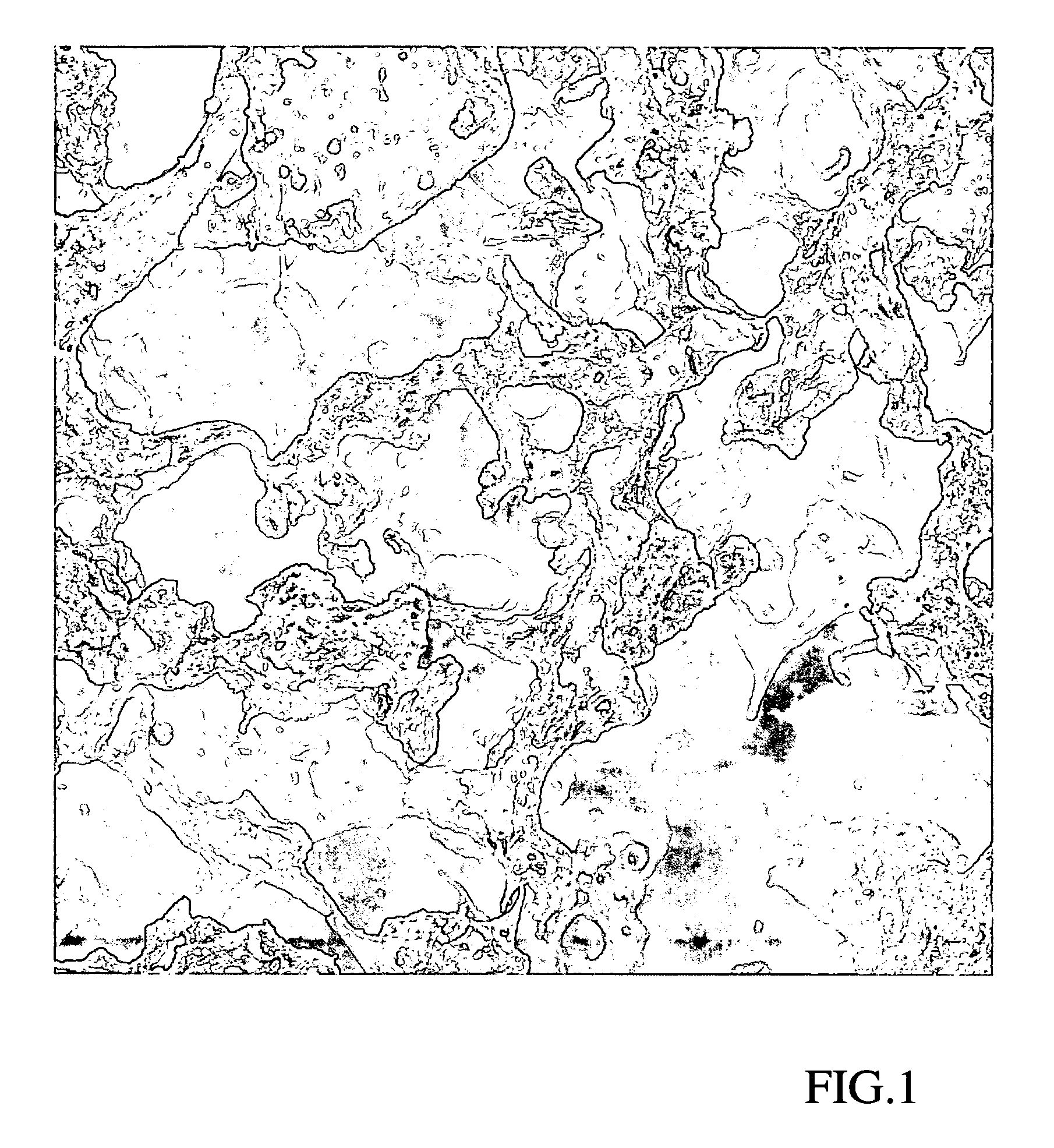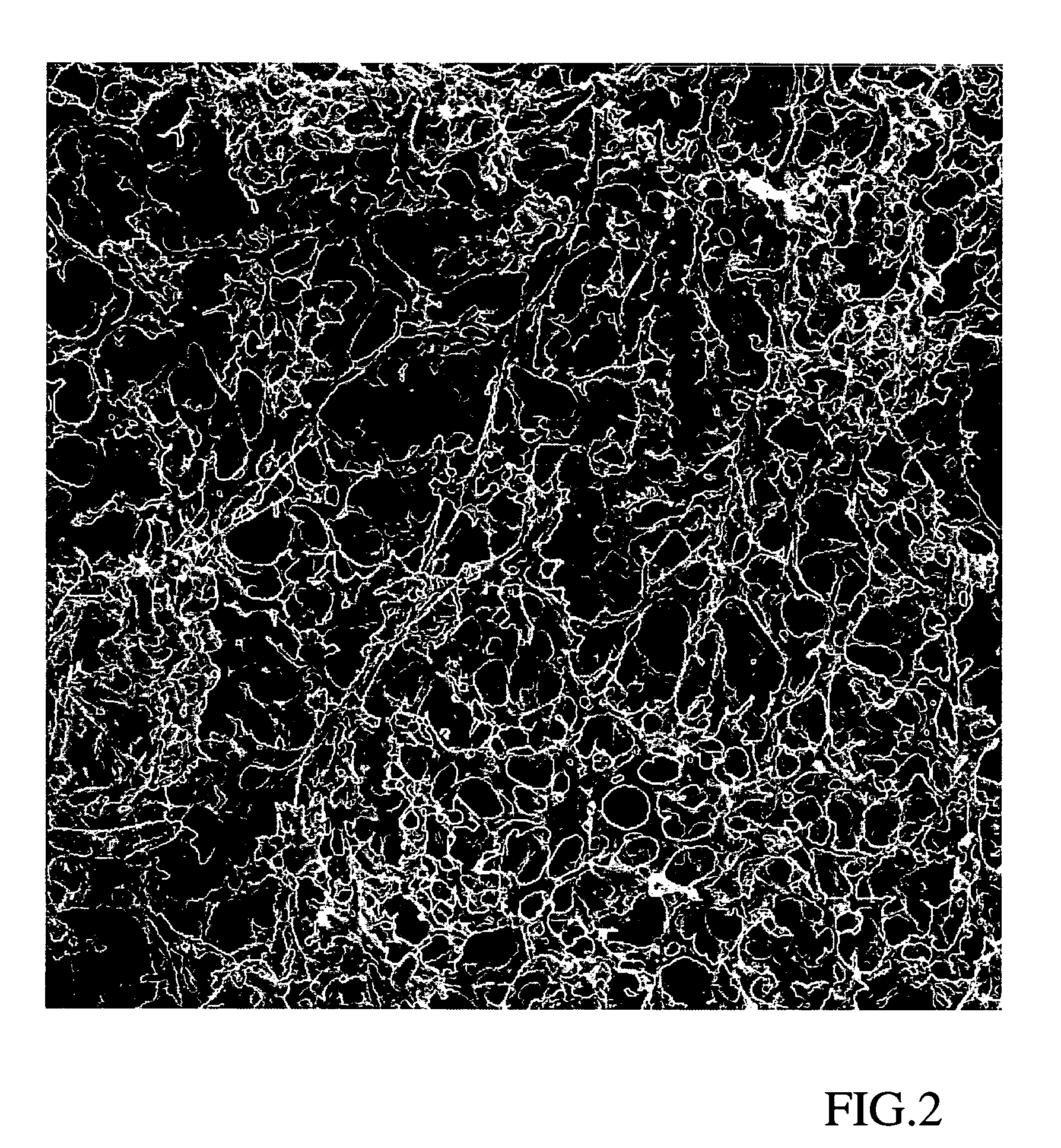Method for preparing an open porous polymer material and an open porous polymer material
a polymer material and polymer technology, applied in the field of preparing an open porous polymer material, can solve the problems of different weaknesses of porous materials obtained by the earlier method of preparing, and achieve satisfactory control
- Summary
- Abstract
- Description
- Claims
- Application Information
AI Technical Summary
Benefits of technology
Problems solved by technology
Method used
Image
Examples
example 1
Preparation of an Open Porous Polymer Material
a) Preparation of Polymer
[0046]A pre-polymer was prepared by reacting polycaprolactondiole [Mn=530] with diphenylmetandiisocyanate (MDI) [NCO:OH]=2:1]. A polymer (fibre polymer) was prepared by chain extension of the pre-polymer with 1,3-diaminopropane. The molecular weight of the fibre polymer was estimated with SEC (“Size Exclusion Chromatography”) in DMF-LiCI against PEO standards and was found to be 113000.
b) Preparation of an open porous polymer material
[0047]100 g of a fibre polymer of polyurethaneurea (9% by weight) which was dissolved in DMF was added to 75 g glucosemonohydrate, and the components were mixed quickly for about 30 seconds. Here the unsieved glucosemonohydrate with an approximate particle size of 0-600 μm was used. The mixture of low viscosity that was obtained was casted to a thin film with a thickness of 2 mm. Then the film was allowed to gel. When further 2 minutes had passed the mixture started to be thick and a...
example 2
Preparation of an Open Porous Polymer Material
[0049]The fibre polymer was prepared according to example 1 a). Then further, in the same way as in example 1, 100 g of a fibre polymer of polyurethaneurea (12% by weight) dissolved in DMF and 75 g glucosemonohydrate. The glucosemonohydrate was here sieved to a size of particles of between 150-250 μm. Here the mixture gelled faster as compared to in example 1. The size of the pores will be less for an open porous polymer material in example 2 as the particles of sugar are less, see FIG. 2. The open porous polymer material in example 2 will also be more rigid because the ratio of polymers is greater in the solution. If an even faster gelling is desired it is possible to increase the ratio of polymer to, for example, 18% by weight. This increase will also give a further rigidity to the resulting open porous polymer material.
[0050]FIG. 2 shows a photograph which has been taken by use of scanning electron microscopy, which shows the size of ...
example 3
Preparation of an Open Porous Polymer Material With Coupled Benzyl Penicillin
a) Preparation of a Polymer with Secondary OH-Groups
[0054]A pre-polymer was prepared by reacting polycaprolactondiole [Mn=530] with diphenylmetandiisocyanate (MDI) [NCO:OH]=2:1]. A polymer (fibre polymer) was prepared by solving 30.46 g of the pre-polymer in 133.6 ml dimethyformamide (DMF), i.e. in 70% of the total amount of DMF. The mixture was stirred under nitrogen gas until a clear solution was obtained which took about 20 minutes. 2.7 g 1.3diamino-2-hydroxypropane and 0.079 g dibutylamine were dissolved in 57.3 ml DMF, i.e. in the remaining amount of DMF. Stirring of the solved pre-polymer was increased and then the mixture of amine and DMF was added at once, and a substantial increase in viscosity was noted.
[0055]Prepared polymer “POL 4040” has 0.88 mmol secondary OH-groups per gram polymer.
[0056]The molecular weight of the polymer was estimated with SEC (Size Exclusion Chromatography) in DMF-LiCI aga...
PUM
| Property | Measurement | Unit |
|---|---|---|
| porosity | aaaaa | aaaaa |
| thickness | aaaaa | aaaaa |
| weight | aaaaa | aaaaa |
Abstract
Description
Claims
Application Information
 Login to view more
Login to view more - R&D Engineer
- R&D Manager
- IP Professional
- Industry Leading Data Capabilities
- Powerful AI technology
- Patent DNA Extraction
Browse by: Latest US Patents, China's latest patents, Technical Efficacy Thesaurus, Application Domain, Technology Topic.
© 2024 PatSnap. All rights reserved.Legal|Privacy policy|Modern Slavery Act Transparency Statement|Sitemap


